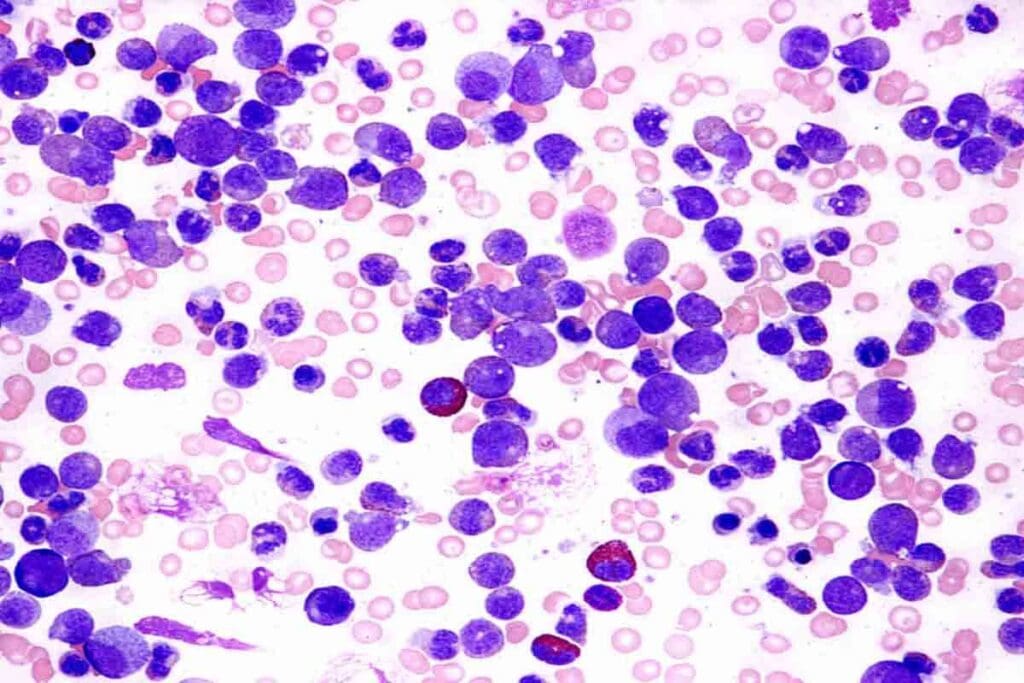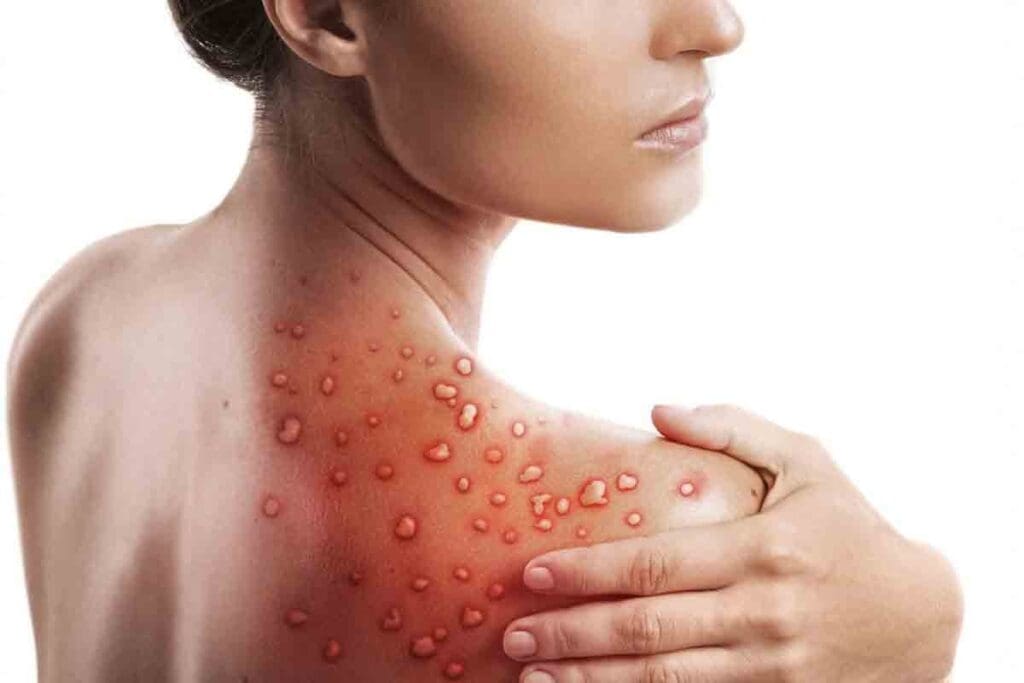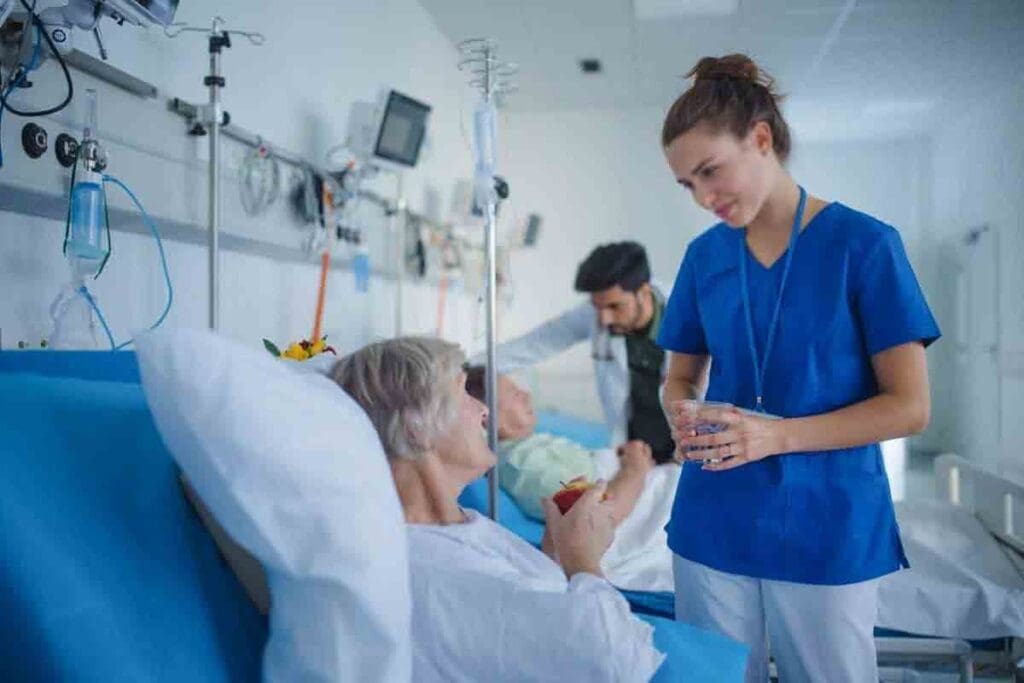Last Updated on November 20, 2025 by Ugurkan Demir

Leukemia is a cancer that affects the blood and bone marrow. It often shows signs on the skin, like petechiae, purpura, and bruising. At Liv Hospital, we know how important it is to spot these signs early.Discover picture of leukemia, rash symptoms, appearance, and signs to detect blood cancer on skin.
Leukemia rash can be a sign of the disease, especially in certain types. We’ll look at the different skin signs of leukemia. We’ll talk about what they look like, their symptoms, and where they show up on the body.
It’s key to understand these signs to get medical help quickly. Our team at Liv Hospital is dedicated to top-notch, patient-focused cancer care.

Leukemia affects more than just the blood; it can also impact the skin. This cancer of the blood and bone marrow can cause various skin symptoms. These occur because leukemia disrupts normal blood cell production.
Leukemia messes with blood cell production, including platelets. Platelets are key for blood clotting. Low platelet counts can cause bleeding under the skin, showing as petechiae or purpura.
These skin changes can be an early warning sign of leukemia. It’s vital to know their causes and signs.
Leukemia and platelet counts are closely linked. The disease can lower platelet production, causing thrombocytopenia. This condition raises the risk of bleeding, visible on the skin.
Petechiae and purpura are common skin manifestations in leukemia patients. They happen when blood leaks from small vessels into the skin, creating spots or patches.
Skin changes in leukemia are more than just cosmetic issues. They are critical warning signs of the disease. Early detection of leukemia is crucial for effective treatment. Skin manifestations play a key role in this process.
We must watch for potential skin symptoms of leukemia. If unusual changes appear, seek medical help. Understanding the link between leukemia and skin symptoms helps identify the disease early.

The skin can show different signs of leukemia. These signs are important for catching the disease early.
Petechiae are small spots on the skin from tiny blood vessel breaks. They happen when there aren’t enough platelets to stop bleeding.
These spots are red or purple and don’t go away when pressed. They can pop up anywhere and are a common sign of leukemia.
Purpura are bigger purple patches from bleeding under the skin. Like petechiae, they happen when blood can’t clot right, often in leukemia.
Purpura can spread or stay in one place. They might come with other signs like tiredness and losing weight.
Bruising and ecchymosis are big areas of bleeding from small injuries. In leukemia, they get worse because of low platelets and clotting problems.
Ecchymosis looks like big bruises and might hurt when touched.
Seeing leukemia skin signs is key to diagnosing it. Photos of these spots can help spot the disease early.
| Skin Manifestation | Description | Common Locations |
| Petechiae | Tiny red or purple spots | Anywhere on the body |
| Purpura | Larger purple patches | Limbs, trunk |
| Bruising/Ecchymosis | Large bruised areas | Anywhere on the body |
Leukemia rash can look different, making it key to have visual guides. Spotting leukemia rash early is vital for treatment. We aim to help doctors and patients spot symptoms quickly.
Petechiae are tiny spots on the skin from small capillary bleeding. In leukemia, they often show up on legs, arms, and torso. These spots are usually red or purple and don’t fade when pressed.
Purpura are larger purple patches from skin bleeding. Leukemia purpura can show up anywhere on the body and may bruise.
Leukemia rash changes as the disease progresses. Knowing these changes helps track the disease and treatment success.
Early stages might show mild symptoms like a few petechiae or small purpura patches. As the disease gets worse, the rash can spread and get more severe.
| Stage | Common Symptoms |
| Early Stage | Petechiae, mild purpura |
| Advanced Stage | Widespread purpura, bruising |
Leukemia cutis is a rare condition where leukemia cells spread to the skin. It shows up as skin lesions that can look different. We’ll look at how to spot leukemia cutis, tell it apart from other rashes, and where it usually shows up on the body.
Leukemia cutis lesions can look like rashes, nodules, or plaques on the skin. These are caused by leukemia cells getting into the skin. The look of these lesions can vary, making it hard to diagnose.
It’s important to know that these lesions can look like other skin issues. A detailed medical check is needed to get a correct diagnosis.
Leukemia cutis is different from other leukemia rashes like petechiae or purpura. These conditions are linked to leukemia but have different causes and looks. For example:
Leukemia cutis, however, is when leukemia cells directly invade the skin. Knowing this difference is key for the right treatment.
Leukemia cutis can show up anywhere on the body but often in certain spots. Common places include:
Knowing where and how leukemia cutis looks can help catch it early and diagnose it correctly.
Knowing where leukemia rash shows up is key for catching it early. This rash can pop up in different spots on the body. Spotting these areas early can help diagnose the disease sooner.
Leukemia rash often shows up on the legs first. In the beginning, it might look like small red or purple spots, called petechiae. These spots happen because of bleeding under the skin, due to low platelet counts, a common problem in leukemia patients.
As leukemia gets worse, the rash on the legs can grow. It might turn into bigger purple patches or purpura. Watching the skin for changes and seeing a doctor if you notice anything odd is very important.
The trunk and upper body are also places where leukemia rash can show up. This rash happens when leukemia cells get into the skin, a condition called leukemia cutis. It looks like red, purple, or brown spots on the skin.
Leukemia rash can also show up on the face and neck, though it’s less common. These spots are noticeable and can be worrying. Swollen lymph nodes in the neck might also show up, which means the disease is spreading.
Facial rash can come with other signs like weight loss, night sweats, or recurring infections. If you see these symptoms, getting medical help right away is very important.
While the legs, trunk, and upper body are where leukemia rash usually appears, it can also show up in other places. These include the arms, hands, and even the mucous membranes in some cases.
“The appearance of leukemia rash in unusual locations can sometimes indicate a more aggressive form of the disease. It’s essential to have any unusual skin manifestations evaluated by a healthcare professional.”
Knowing where leukemia rash can appear helps both patients and doctors watch for signs of the disease. Catching it early is key for effective treatment and better outcomes.
Purpura rash is a sign that might mean leukemia. It shows as purple or red spots on the skin from bleeding under the skin. Early detection of leukemia is crucial for effective treatment and better patient outcomes.
Leukemia can cause skin issues like purpura rash, petechiae (tiny red or purple spots), and bruising. These happen because the disease affects blood cells and platelets. Recognizing these early signs is key to getting medical help fast.
A simple test for purpura rash is the non-blanching test. When pressed, purpura spots don’t fade or blanch because they’re from bleeding into the skin. This makes purpura different from other rashes that might blanch. The non-blanching nature of purpura rash is a significant indicator that needs more medical check-up.
Not all rashes mean leukemia, but some signs need quick medical help. Look for rapid onset, widespread spots, and symptoms like fever, fatigue, or unexplained weight loss. If you or someone you know is experiencing these symptoms, getting medical care right away is crucial.
Knowing the early signs of leukemia, like purpura rash, can help get a diagnosis and treatment sooner. We stress the importance of being aware of these signs and getting medical check-ups if you see them.
Acute lymphoblastic leukemia (ALL) can show up in different ways, including rashes. It’s a blood cancer that affects the bone marrow. This can cause various symptoms, including skin problems.
ALL can show unique skin signs, like petechiae, purpura, and ecchymosis. These happen because leukemia can lower platelet counts. Petechiae are small, pinpoint spots from tiny blood vessel breaks.
Purpura are larger, purple patches on the skin. They also come from bleeding under the skin. Seeing these signs could mean ALL is present.
ALL also brings other symptoms, like fatigue, weight loss, fever, and bone pain. Patients might also have anemia, causing paleness and shortness of breath. These symptoms, along with skin signs, should lead to further tests for ALL.
While ALL symptoms are similar, there are age differences. Children often show fever and bone pain, while adults might feel tired and lose weight.
However, skin signs like petechiae and purpura are common in both. Knowing these differences helps in diagnosing and treating ALL correctly.
Children with leukemia might get rashes that look like common childhood issues. It’s key for parents and doctors to know about these rashes. This helps get the right diagnosis and treatment quickly.
Leukemia in kids shows different rashes than in adults. These rashes come from the disease affecting blood cells and platelets. They can look like tiny red or purple spots, larger purple patches, or bruising. Spotting these signs early is important for diagnosis.
Leukemia can mess with blood cell production, causing low platelet counts. This can lead to these skin issues. Catching these signs early is key to finding leukemia.
They show the different types of rashes, from small spots to big patches.
Looking at these pictures helps understand the differences between leukemia rashes and other common skin issues in kids.
It’s hard to tell leukemia rashes from other common skin problems in kids. Things like eczema, viral rashes, or bug bites can look similar. But leukemia rashes don’t fade when pressed (non-blanching rash).
Watching these rashes closely is important. If they don’t go away or come with other symptoms like fever or tiredness, get medical help.
If a rash looks like it might be from leukemia, see a doctor right away. Look out for widespread rashes, bleeding gums, nosebleeds, or other bleeding signs.
Quick diagnosis and treatment are crucial for kids with leukemia. Being careful about any unusual rashes and talking to a doctor is very important.
Leukemia can cause many symptoms that affect a patient’s comfort and health. It’s important to know about these symptoms for better care and support.
An itchy skin rash is a common symptom of leukemia. This itchiness can be from the disease or its treatment. It’s crucial to manage it well to improve a patient’s life quality.
Managing Itchy Skin Rash:
Itching and bruising are common in leukemia patients. Bruising happens when platelet counts are low. It’s important to avoid injuries to prevent bruising.
| Symptom | Cause | Management |
| Itching | Disease or treatment side effect | Topical treatments, moisturizing |
| Bruising | Low platelet count | Avoiding injuries, platelet transfusions |
Pain and discomfort are big concerns for leukemia patients. Pain can come from bone marrow expansion or enlarged lymph nodes.
Effective pain management strategies include:
Hives, or urticaria, can be linked to leukemia, but it’s rare. Hives might be a reaction to medication or an immune response. If hives appear, seeing a healthcare provider is key to find out why.
It’s crucial to recognize and manage symptoms and complications of leukemia. By understanding the causes and using the right strategies, patients and healthcare providers can improve life quality.
It’s very important to spot leukemia rash early. We talked about different skin signs like petechiae, purpura, and leukemia cutis. Catching these signs early can help get the right treatment faster.
Acting fast when you see unusual skin changes is key. If you notice anything odd, get help right away. A doctor can check it out and give the right diagnosis. This is crucial for treating leukemia well.
Knowing about leukemia rashes helps us spot warning signs. This knowledge lets us act quickly to get medical help. It’s a big step towards better health.
Leukemia can cause skin symptoms like petechiae, purpura, bruising, and ecchymosis. This is because it affects platelet production and blood clotting.
A leukemia rash can look like small red or purple spots (petechiae) or larger purple patches (purpura). It can also appear as bruising and ecchymosis. The look can change based on the type of leukemia and the person’s skin.
Leukemia rash can show up on different parts of the body. This includes the legs, trunk, upper body, face, and neck. Where it appears can depend on the type of leukemia and the person.
Leukemia cutis is when leukemia cells show up on the skin, causing lesions. It’s identified by finding leukemia cells in the skin. It can be told apart from other leukemia rashes with diagnostic tests.
Purpura is a larger purple patch that can be a sign of leukemia. It happens when there are low platelet counts. It’s a non-blanching rash, meaning it doesn’t fade when pressed.
Yes, leukemia can cause an itchy skin rash. The exact reason isn’t always clear. Itching can be linked to various leukemia symptoms, including skin issues.
Leukemia in children can show different skin symptoms. It’s important to tell these apart from common childhood rashes. Parents should get immediate medical help if they think their child has leukemia.
While hives aren’t a typical sign of leukemia, there might be cases where they are linked. More research is needed to understand this possible connection.
Early signs of leukemia include purpura rash, petechiae, and other skin symptoms. If you or someone you know has these symptoms, getting medical help right away is crucial.
Diagnosing leukemia rash involves a physical exam, medical history, and tests. These include blood tests and skin biopsies to find the cause of the skin symptoms.
Subscribe to our e-newsletter to stay informed about the latest innovations in the world of health and exclusive offers!